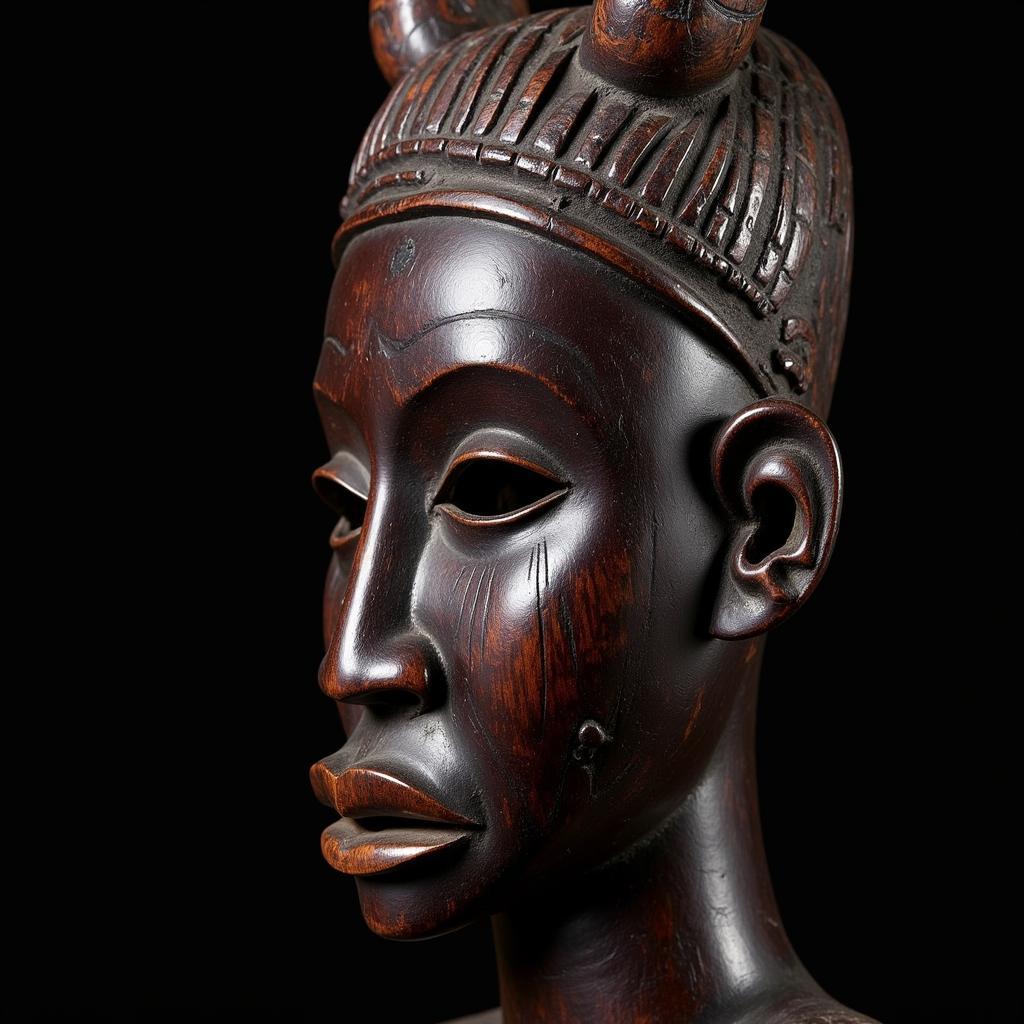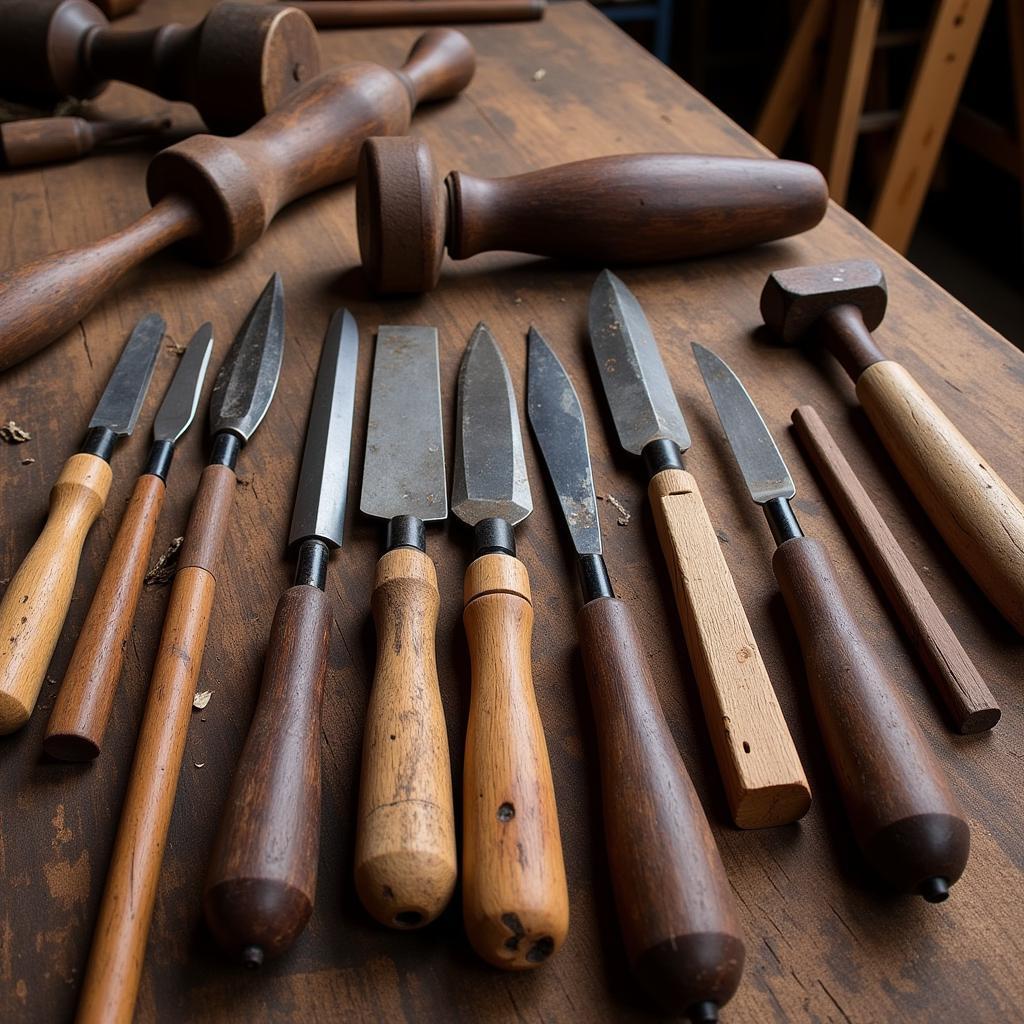Unveiling the Art of African Blackwood Carvings
African Blackwood Carvings represent a rich tapestry of cultural heritage and artistic skill, transforming a rare and precious wood into objects of beauty and significance. From intricate masks and figures to finely crafted musical instruments and furniture, these carvings showcase the deep connection between African communities and their natural environment. This article delves into the world of African blackwood carvings, exploring their history, significance, and the intricate processes involved in their creation.
The allure of African blackwood carvings lies not only in their aesthetic appeal but also in the stories they tell. These carvings are more than just decorative objects; they are embodiments of cultural beliefs, historical narratives, and spiritual values. Passed down through generations, they serve as tangible links to the past, preserving ancestral wisdom and traditions.
African blackwood, known scientifically as Dalbergia melanoxylon, is a dense and durable hardwood found primarily in the dry savannas of East Africa. Its rich, dark color and fine texture make it highly sought after for carving, giving rise to a unique artistic tradition that has captivated the world. The wood’s resistance to termites and decay further enhances its value, ensuring the longevity of the carvings. Working with African blackwood requires immense skill and patience due to its density. Carvers utilize specialized tools, often passed down through families, to shape and refine the wood, gradually revealing the intricate details of their designs.
The earliest examples of African blackwood carvings date back centuries, showcasing the evolution of artistic styles and techniques across different regions and ethnic groups. From the Makonde carvers of Tanzania, renowned for their expressive masks and figures, to the skilled artisans of Mozambique who create elaborate musical instruments, each community has developed its own distinctive style, reflecting its unique cultural identity.
African blackwood carvings hold a prominent place in traditional ceremonies and rituals. Masks, often representing spirits or ancestors, are used in dances and performances, connecting the living with the spiritual realm. Figurines depicting deities or important figures serve as focal points for prayers and offerings, embodying the community’s spiritual beliefs. The use of African blackwood in these sacred objects underscores the wood’s cultural and spiritual significance.
Beyond their ceremonial use, African blackwood carvings also play a vital role in everyday life. Utilitarian objects, such as bowls, spoons, and headrests, are crafted with both functionality and artistry in mind, demonstrating the seamless integration of art into daily routines. The durability and beauty of African blackwood make these objects cherished possessions, passed down through families and imbued with personal meaning.
This practice continues to thrive in many communities, providing livelihoods for skilled artisans and preserving a valuable cultural heritage. Modern African blackwood carvers often draw inspiration from traditional motifs while also incorporating contemporary elements, creating pieces that resonate with both local and global audiences.
 Intricate African Blackwood Mask Carving
Intricate African Blackwood Mask Carving
The increasing demand for African blackwood has raised concerns about the sustainability of the tree. Efforts are underway to promote sustainable harvesting practices and reforestation programs to ensure the long-term survival of this precious resource. Organizations are working with local communities to develop sustainable forestry management plans and empower artisans to become stewards of the forest. Supporting these initiatives is crucial to preserving both the artistic tradition and the ecological balance of the region. For more on the uses of African blackwood, see african blackwood uses.
The Significance of African Blackwood in Cultural Practices
African blackwood holds a deep-rooted significance in many African cultures, representing more than just a material for carving. It is often associated with spiritual power, ancestry, and cultural identity. In some communities, the tree itself is considered sacred, and rituals are performed before harvesting the wood. This reverence for the material adds another layer of meaning to the carvings, imbuing them with a spiritual and cultural potency.
Mastering the Art of Blackwood Carving: Tools and Techniques
Creating African blackwood carvings requires specialized tools and techniques passed down through generations of artisans. Carvers use a variety of chisels, adzes, and knives to shape the wood, carefully removing thin layers to reveal the intricate details of their designs. The process is often slow and meticulous, demanding both patience and precision.
 Traditional African Blackwood Carving Tools
Traditional African Blackwood Carving Tools
Many carvers also incorporate traditional techniques, such as burning and staining, to enhance the beauty and durability of their work. These techniques add unique textures and colors to the carvings, further enriching their artistic expression. You can explore different types of African hardwood lumber at african hardwood lumber. For more information about the African ebony tree, visit african ebony tree.
The Future of African Blackwood Carvings
Despite the challenges of sustainability and globalization, the tradition of African blackwood carving continues to thrive. Young artists are learning from their elders, carrying on the legacy of their ancestors and adapting their skills to meet the demands of a changing world. The growing appreciation for African art on the global stage has created new opportunities for carvers to share their work with a wider audience.
Conclusion
African blackwood carvings represent a powerful testament to the artistic ingenuity and cultural richness of Africa. These intricate creations tell stories, embody beliefs, and connect generations, preserving a valuable heritage for the future. By understanding the history, significance, and the intricate processes involved in their creation, we can truly appreciate the artistry and cultural depth embedded within each piece. For further insights on the African blackwood tree, see african blackwood tree images. If you’re interested in the presence of African blackwood in India, check out african blackwood in india.
FAQ
- What makes African blackwood so special for carving? Its density, rich color, and resistance to decay make it ideal for intricate carvings.
- Where does African blackwood come from? Primarily the dry savannas of East Africa.
- What are some common motifs found in African blackwood carvings? Masks, figures, animals, and abstract patterns.
- How are African blackwood carvings made? Using specialized tools like chisels, adzes, and knives, combined with traditional techniques like burning and staining.
- Are African blackwood carvings still made today? Yes, the tradition thrives, with both traditional and contemporary styles being created.
- What are the conservation concerns surrounding African blackwood? Overharvesting threatens the tree’s survival, highlighting the need for sustainable practices.
- Where can I learn more about African blackwood carvings? Museums, cultural centers, and online resources offer valuable information.
Need assistance? Contact us at +255768904061, kaka.mag@gmail.com, or visit us at Mbarali DC Mawindi, Kangaga, Tanzania. We offer 24/7 customer support.

